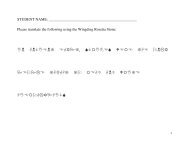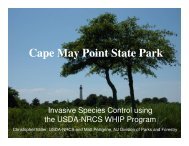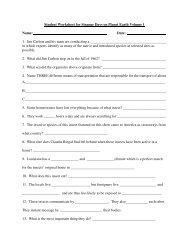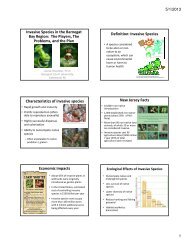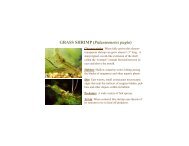Norway Maple (Acer platanoides) Japanese Barberry (Berberis ...
Norway Maple (Acer platanoides) Japanese Barberry (Berberis ...
Norway Maple (Acer platanoides) Japanese Barberry (Berberis ...
You also want an ePaper? Increase the reach of your titles
YUMPU automatically turns print PDFs into web optimized ePapers that Google loves.
Status: Invasive.<br />
Native to: Europe.<br />
Feral cat (Felix cattus)<br />
Effects: There are more than 70 million feral cats<br />
roaming the US today. Fierce hunters, each one eats<br />
several small mammals or birds every day. They also<br />
eat insects, reptiles, amphibians and even fish. Every<br />
year billions of native animals are killed and eaten by<br />
these animals. This adds to the stress of habitat loss,<br />
and can strongly reduce the ability of native species to<br />
survive.<br />
http://www.taiko.org.nz/cat1.jpg<br />
http://www.ew.govt.nz/PageFiles/3529/rats2.jpg<br />
Distinctive features: Although descended from house<br />
cats, feral cats tend to be smaller and much fiercer.<br />
After a few generations, feral cats lose the diversity<br />
of their pampered brethren and to revert to black,<br />
tabby or tortoiseshell fur patterns, often with some<br />
white on the belly and breast.<br />
Earth worms (Lumbricus terrestris)<br />
Status: Invasive.<br />
Native to: Europe.<br />
Effects: New Jersey has no native earthworms. All<br />
the worms you see today are descendents of worms<br />
that arrived in soil around plants imported by<br />
European settlers in the last few centuries. As a<br />
result, our forests evolved without worms and normal<br />
forest development depends on the accumulation of<br />
undecayed leaf matter. When worms decompose that<br />
leaf layer, the ecology shifts, making the habitat<br />
unsuitable for certain species of trees, ferns and<br />
wildflowers.<br />
http://img210.imageshack.us/i/lumbricusterrestris2.jpg/<br />
Distinctive features: This is a relatively large species<br />
earthworm. It is pinkish to reddish-brown in color and<br />
typically reaches 10-25 cm in length.



